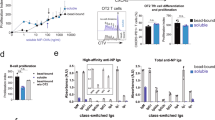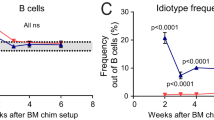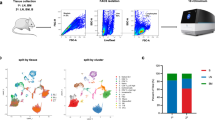Abstract
It is well known that B cells require T-cell help to produce specific antibody. Classic experiments suggested that antigen-specific helper T cells interact with antigen-specific B cells via an antigen ‘bridge’1,2, the B cells binding to one determinant on an antigen molecule (the ‘hapten’), while the T cells at the same time recognize another determinant (the ‘carrier’). T-helper cells bind specifically to antigen-presenting cells (APC), which have picked up and processed the appropriate antigen, and this interaction, like the interaction of T-helper cells with specific B cells, is restricted by products encoded by the major histocompatibility complex (MHC)3–5. Whereas conventional APC such as macrophages display no binding specificity for antigen, B cells have clonally distributed antigen-specific surface immunoglobulin receptors which would be expected to enhance their capacity to present antigen to T cells6,7. These findings are difficult to reconcile with the simple ‘antigen bridge’ mechanism of interaction, because it is hard to visualize how the bimolecular complex (processed antigen plus MHC molecule) on the APC surface can resemble the trimolecular complex (antigen bound to surface immunoglobulin plus MHC molecule) on the B-cell surface. To address this problem, we have cloned and immortalized human antigen-specific B cells with Epstein–Barr virus (EBV) and analysed their interaction with T-cell clones specific for the same antigen. We report here that surface immunoglobulin is indeed involved in the uptake and concentration of antigen, allowing specific B cells to present antigen to T cells with very high efficiency. However, the antigen must first be internalized and processed by specific B cells and it is then presented to T cells in an MHC-restricted manner indistinguishable from that characteristic of conventional APC.
This is a preview of subscription content, access via your institution
Access options
Subscribe to this journal
Receive 51 print issues and online access
$199.00 per year
only $3.90 per issue
Buy this article
- Purchase on Springer Link
- Instant access to full article PDF
Prices may be subject to local taxes which are calculated during checkout
Similar content being viewed by others
References
Mitchison, N. A. Eur. J. Immun. 1, 18–27 (1971).
Rajewsky, K., Schirrmacher, W., Nase, S. & Jerne, N. K. J. exp. Med. 129, 1131–1136 (1969).
Rosenthal, A. S. & Shevach, E. M. J. exp. Med. 138, 1194–1212 (1973).
Unanue, E. R., Beller, D. I., Lu, C. Y. & Allen, P. M. J. Immun. 132, 1–5 (1984).
Katz, D. H., Hamaoka, M. E. & Benacerraf, B. Proc. natn. Acad. Sci. U.S.A. 70, 2624–2628 (1973).
Kakiuki, T., Chestnut, R. W. & Grey, H. M. J. Immun. 131, 109–114 (1982).
Rock, K. L., Benacerraf, B. & Abbas, A. K. J. exp. Med. 160, 1102–1113 (1984).
Benacerraf, B. J. Immun. 120, 1809–1812 (1978).
Ziegler, H. K. & Unanue, E. R. Proc. natn. Acad. Sci. U.S.A. 79, 175–178 (1982).
Shimonkevitz, R., Kappler, J., Marrack, P. & Grey, H. J. exp. Med. 158, 303–316 (1983).
Lanzavecchia, A., Parodi, B. & Celada, F. Eur. J. Immun. 13, 733–738 (1983).
Celada, F., Macario, A. J. L. & Conway De Macario, E. Immunonochemistry 10, 797–804 (1973).
Rosen, A., Persson, K. & Klein, G. J. Immun. 130, 2899–2902 (1983).
Author information
Authors and Affiliations
Rights and permissions
About this article
Cite this article
Lanzavecchia, A. Antigen-specific interaction between T and B cells. Nature 314, 537–539 (1985). https://doi.org/10.1038/314537a0
Received:
Accepted:
Issue Date:
DOI: https://doi.org/10.1038/314537a0
This article is cited by
-
Tango of B cells with T cells in the making of secretory antibodies to gut bacteria
Nature Reviews Gastroenterology & Hepatology (2023)
-
Avrion Mitchison (1928–2022)
Nature Immunology (2023)
-
Antigen presentation by B cells enables epitope spreading across an MHC barrier
Nature Communications (2023)
-
Advancing Biologic Therapy for Refractory Autoimmune Hepatitis
Digestive Diseases and Sciences (2022)
-
B cell depletion with anti-CD20 mAb exacerbates anti-donor CD4+ T cell responses in highly sensitized transplant recipients
Scientific Reports (2021)
Comments
By submitting a comment you agree to abide by our Terms and Community Guidelines. If you find something abusive or that does not comply with our terms or guidelines please flag it as inappropriate.



